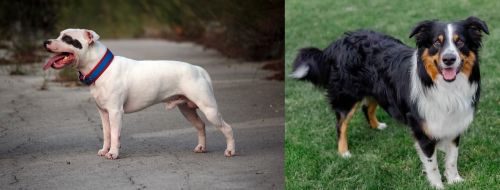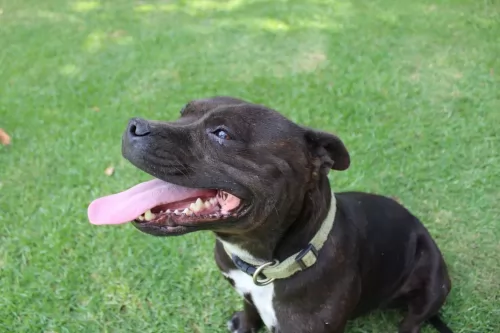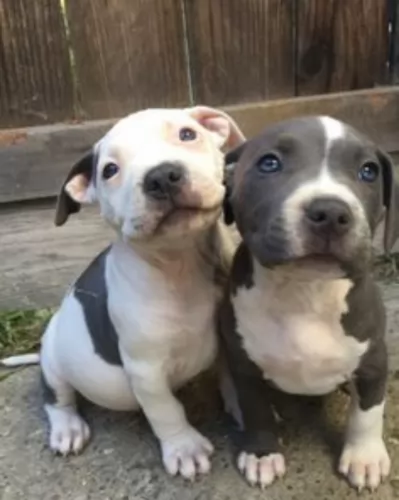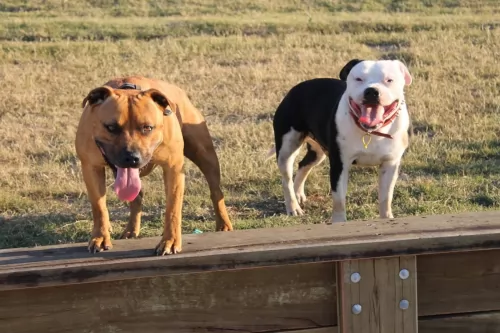 MyDogBreeds
MyDogBreeds Staffordshire Bull Terrier is originated from United Kingdom but English Shepherd is originated from United States. Staffordshire Bull Terrier may grow 17 cm / 6 inches shorter than English Shepherd. Staffordshire Bull Terrier may weigh 11 kg / 24 pounds lesser than English Shepherd. Both Staffordshire Bull Terrier and English Shepherd has same life span. Both Staffordshire Bull Terrier and English Shepherd has almost same litter size. Both Staffordshire Bull Terrier and English Shepherd requires Low maintenance.
Staffordshire Bull Terrier is originated from United Kingdom but English Shepherd is originated from United States. Staffordshire Bull Terrier may grow 17 cm / 6 inches shorter than English Shepherd. Staffordshire Bull Terrier may weigh 11 kg / 24 pounds lesser than English Shepherd. Both Staffordshire Bull Terrier and English Shepherd has same life span. Both Staffordshire Bull Terrier and English Shepherd has almost same litter size. Both Staffordshire Bull Terrier and English Shepherd requires Low maintenance.
 The Staffordshire Bull Terrier was first developed in the northern sections of Birmingham and in Staffordshire, England. The Staffie is a cross between a Black and Tan Terrie and the Bulldog, but had other breeds crossed in over time in order to create a bull-baiting dog and a fighting dog. In the Victorian age these sports were banned but dog fighting went underground and continues on some level today.
The Staffordshire Bull Terrier was first developed in the northern sections of Birmingham and in Staffordshire, England. The Staffie is a cross between a Black and Tan Terrie and the Bulldog, but had other breeds crossed in over time in order to create a bull-baiting dog and a fighting dog. In the Victorian age these sports were banned but dog fighting went underground and continues on some level today.
The Staffordshire Bull Terrier was exceptional at these “sports” due to his build, power and jaw strength. Today’s Staffie is a descendent of those early Bull Terrier crosses. Together with the Bull Terrier and the American Pit Bull, the Staffie also traces its roots back to those original English Bully dogs. All three breeds have the Bulldog in common.
After dog fighting and bull baiting were banned the Stafforshire Bull Terrier was further developed as a companion and pet. Still their reputation as fighting dogs cost them recognition in the official kennel clubs for some time. They finally made the UK registry in 1935, but it was not until 1974 that the American Kennel Club (AKC) accepted them.
 The English Shepherd is another dog with an English name that was developed in the United States. They developed from British farm dogs that were brought to the United States in the 17th, 18th and 19th centuries by the Scottish and English as they settled in the New World. Tracing their line through working dogs and collies in Scotland and northern England, the settlers bred them with local dogs and each other. These working farm dogs were called English Shepherds, Scotch Collies, barnyard collie, farm shepherd, the cow dog, and the old fashioned shepherd.
The English Shepherd is another dog with an English name that was developed in the United States. They developed from British farm dogs that were brought to the United States in the 17th, 18th and 19th centuries by the Scottish and English as they settled in the New World. Tracing their line through working dogs and collies in Scotland and northern England, the settlers bred them with local dogs and each other. These working farm dogs were called English Shepherds, Scotch Collies, barnyard collie, farm shepherd, the cow dog, and the old fashioned shepherd.
The English Shepherd was appreciated by the settlers and farmers because he was a versatile dog that could herd their flocks and protect their homes as well. They appreciated his intelligence and ability to hunt vermin and be a companion for their children. English Shepherds were bred to work with a variety of livestock such as pigs, cattle, goats, sheep and fowl. They were used to hunt as well and were known to track racoons and squirrels and tree them. There wasn’t a more popular dog in the American Midwest and East in the 1800’s and 1900’s.
The breed is trustworthy, alert and independent. As the small family farms were replaced by large agricultural enterprises the English Shepherd’s numbers dwindled as well until he fell into the category of a rare breed. There were no clubs to support it and not AKC recognition. The UKC had a different dog registered as a farm shepherd.
Today’s English Shepherd is still a farm dog, but he also hunts, is a therapy dog, competes in AKC trials, and performs search and rescue duties. As a farm dog, they are still the most desirable due to their versatility in working with different livestock, guarding the home and caring for the children. They do these things in a gentle way if possible but can be tough if needed. They have great empathy for the livestock and for their human family. This makes him a great dog for the family. The English Shepherd has remained a farm dog, working dog more than a show dog, over all these years.
 The Staffordshire is a muscular, stocky and unusually strong breed, small to medium size in height and build. They have broad, powerful chests, wide set, strong legs, strong shoulders, broad head with a fairly short muzzle. Their ears are not cropped but they are short and fold over. The coat is stiff, close and short and the tail is medium and carried low. Most Staffies are brown, but they can be red, brindle with white, fawn, black, white or blue.
The Staffordshire is a muscular, stocky and unusually strong breed, small to medium size in height and build. They have broad, powerful chests, wide set, strong legs, strong shoulders, broad head with a fairly short muzzle. Their ears are not cropped but they are short and fold over. The coat is stiff, close and short and the tail is medium and carried low. Most Staffies are brown, but they can be red, brindle with white, fawn, black, white or blue.
 The American bred English Shepherd is a medium sized dog that looks somewhat like an Australian Shepherd or Border Collie. They have tails, never come in merle coloring and their head is not as rounded as the Australian Shepherd. A working dog, its proportionally very well balanced. Because the English Shepherd is so popular across the country, doing a wide variety of jobs, there is some regional differences in the dogs.
The American bred English Shepherd is a medium sized dog that looks somewhat like an Australian Shepherd or Border Collie. They have tails, never come in merle coloring and their head is not as rounded as the Australian Shepherd. A working dog, its proportionally very well balanced. Because the English Shepherd is so popular across the country, doing a wide variety of jobs, there is some regional differences in the dogs.
The coat can be curly or straight with feathering around the tail, ears and legs. Their heads are slightly rounded but broad and the muzzle is also broad with a solid black nose except for the clear sable dogs whose nose is brown. The eyes show you how intelligent and strong this breed is, and they should be round, brown and oblique. The ears are close to the head and wide apart.
With a strong, muscular back and shoulders the English Shepherd can do almost anything you ask him to. His legs are strong and straight, and his hind legs are muscular. His feet are compact, oval and well padded.
 1.Children friendliness The breed adores children but care should still be taken because they are so strong and their jaws are so powerful.
1.Children friendliness The breed adores children but care should still be taken because they are so strong and their jaws are so powerful.
2.Special talents they adore children and they one of the most powerful jaws among canines.
 It may seem strange to talk about kindness in a working dog, but it is one of the defining traits of the English Shepherd, along with intelligence. The breed is extremely kind to everyone he lives with animals and people. Once he is secure in his job and takes in his children or his herd, he is one of the best caretakers around. He is an independent thinker, is easily trained, and highly affectionate. However, he does see himself as the boss and unless you establish yourself in that alpha role you could have problems.
It may seem strange to talk about kindness in a working dog, but it is one of the defining traits of the English Shepherd, along with intelligence. The breed is extremely kind to everyone he lives with animals and people. Once he is secure in his job and takes in his children or his herd, he is one of the best caretakers around. He is an independent thinker, is easily trained, and highly affectionate. However, he does see himself as the boss and unless you establish yourself in that alpha role you could have problems.
 • Patella luxation otherwise known as a slipped kneecap- can cause pain and some lameness.
• Patella luxation otherwise known as a slipped kneecap- can cause pain and some lameness.
• Skin allergies and even a tendency toward Mange which is chronic in some forms and fatal in others.
• Like most active dogs their size, they are susceptible to bloat which can be fatal if not treated immediately.
 Like many other herding breeds, it has been found that about 15% of English Shepherds had a gene mutation called MDR1. This means they have adverse reaction and high sensitivity to many common drugs for dogs. This condition could be life-threatening so test your dog for it and know what you are up against.
Like many other herding breeds, it has been found that about 15% of English Shepherds had a gene mutation called MDR1. This means they have adverse reaction and high sensitivity to many common drugs for dogs. This condition could be life-threatening so test your dog for it and know what you are up against.
 1.Feeding the puppy Don’t over feed as he grows fast. Feed a high quality dog food for medium size puppies. Feed 1-2 and a quarter cups in 3-4 meals per day.
1.Feeding the puppy Don’t over feed as he grows fast. Feed a high quality dog food for medium size puppies. Feed 1-2 and a quarter cups in 3-4 meals per day.
2.Feeding the adult Don’t exercise right before or after eating due to potential for bloat. Feed 1-2 times a day a high quality medium breed dog food.
4. Games and Exercises They are terriers after all and they dig. Need a fairly large yard with a strong fence. They love to play ball, frisbee and can excel at cart pulling.
 Remember the English Shepherd is a hard working dog. But if you don’t work him don’t overfeed him. Twice a day, he needs about one half cup of a good quality dry food made with an active, medium sized dog in mind.
Remember the English Shepherd is a hard working dog. But if you don’t work him don’t overfeed him. Twice a day, he needs about one half cup of a good quality dry food made with an active, medium sized dog in mind.
In addition to the health concern listed above, the English Shepherd is also prone to:
Both elbow and hip dysplasia can plaque the English Shepherd as it does almost any active breed. Have your puppy tested as it can cause lameness and arthritis.
This is a herding breed and they need exercise. They need a job. They are intelligent and work oriented so make sure they have something to do. Take them to herding trails and have their herding instinct tested. Put them to work in flyball, agility, frisbee, tracking, obedience, rally, herding and showmanship events. Just make sure your English Shepherd has enough to keep his mind and body stimulated at a high rate every day.